前景英语unit7教案
- 格式:doc
- 大小:68.50 KB
- 文档页数:8
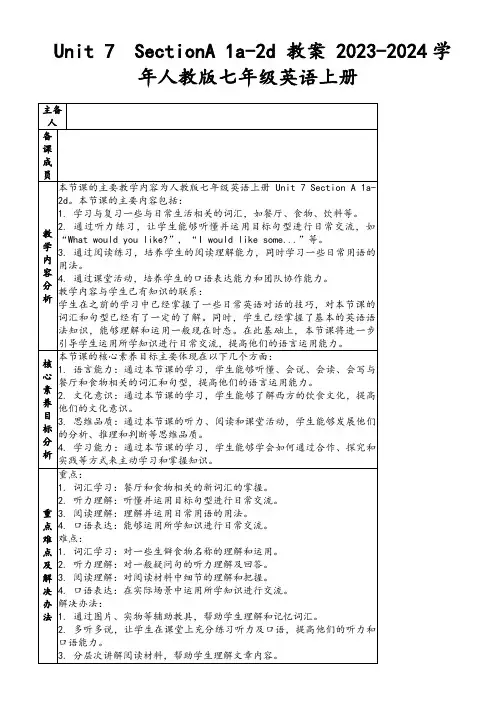
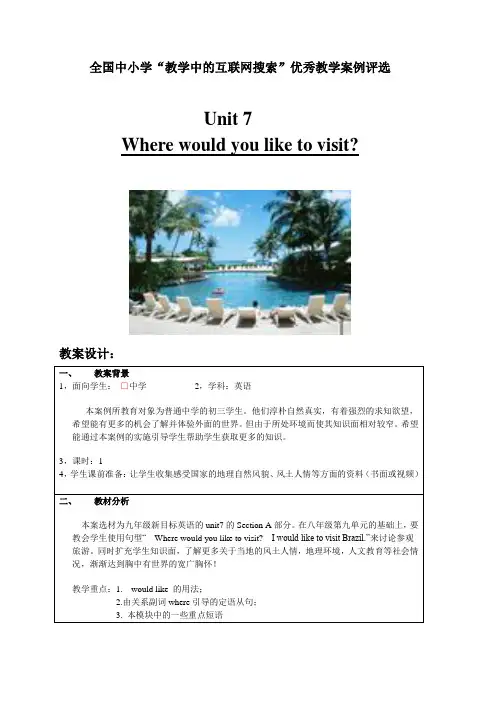

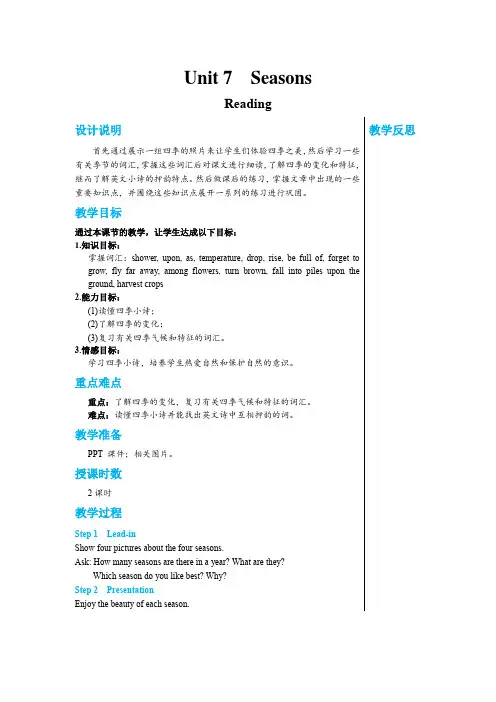
Unit 7 SeasonsReading设计说明教学反思首先通过展示一组四季的照片来让学生们体验四季之美,然后学习一些有关季节的词汇,掌握这些词汇后对课文进行细读,了解四季的变化和特征,继而了解英文小诗的押韵特点。
然后做课后的练习,掌握文章中出现的一些重要知识点,并围绕这些知识点展开一系列的练习进行巩固。
教学目标通过本课节的教学,让学生达成以下目标:1.知识目标:掌握词汇:shower, upon, as, temperature, drop, rise, be full of, forget togrow, fly far away, among flowers, turn brown, fall into piles upon theground, harvest crops2.能力目标:(1)读懂四季小诗;(2)了解四季的变化;(3)复习有关四季气候和特征的词汇。
3.情感目标:学习四季小诗,培养学生热爱自然和保护自然的意识。
重点难点重点:了解四季的变化,复习有关四季气候和特征的词汇。
难点:读懂四季小诗并能找出英文诗中互相押韵的词。
教学准备PPT 课件;相关图片。
授课时数2课时教学过程Step 1 Lead-inShow four pictures about the four seasons.Ask: How many seasons are there in a year? What are they?Which season do you like best? Why?Step 2 PresentationEnjoy the beauty of each season.Say: Different people like different seasons just because each season has its own beauty.(about winter)As the days are shorter and the temperature drops, winter is coming. It’s cold in winter. Sometimes it’s snowy. The ground is covered with snow. Trees and flowers forget to grow. Birds fly far away.(about spring)Spring is the best season of the year. It’s warm and windy. It’s the best time to fly kites. Bees and butterflies play among flowers. If the rain comes, they hide from the April showers.(about summer)Summer is hot, but we can enjoy a long summer holiday. What can we do in summer? It is hot. The sun shines. We can swim in the sea. We can eat ice cream. There are also quiet streams, trees and shade. I like chatting or reading in the shade of trees in the middle of the day. The temperature rises quickly at that time.(about autumn)What colour are the leaves? In autumn. The leaves turn brown. They are yellow, red, gold and brown. They fall into piles upon the ground. Autumn is a harvest season.Step 3 ReadingTask 1 ScanningRead the poem quickly and try to fill in blanks.Winter days are full of___________.Trees and flowers forget to___________.The birds fly____________ away to find a warm and sunny day.Spring is a perfect time to fly__________.We can see some bees and_________.It is so hot in summer that we all like to eat ___________ to feel cool.We can also drink some water from a ___________ between mountains. Autumn leaves turn ___________.They fall into ___________ upon the ground.The days are shorter and the temperature___________.Answers: snow, grow, far,kites, butterflies, ice cream, stream,brown, piles, dropsTask 2 Further reading1. Read the first paragraph of the poem and answer the questions.Q1: Can trees and flowers grow in winter?Q2: Why do the birds fly far away?Answers: 1. No,they cannot. 2. To find a warm and sunny day.2. Read the second paragraph of the poem and answer the question.Q: What do bees and butterflies do in spring?Answer: They play among flowers, and then hide from the April showers.3. Read the third paragraph of the poem and answer the question.Q: Where can we often play in summer?Answer: We can play by quiet streams or under the shade of the trees.4. Read the fourth paragraph of the poem and answer the questions.Q1: Where can we see piles of autumn leaves?Q2: What are farmers busy doing in autumn?Answers: 1. On the ground. 2. They are busy harvesting crops.Task 3 Post readingEnjoy the beauty of the poem.1. Please read together with the tape. Pay attention to the poem’s stops.Winter days/ are full of snow,When trees and flowers/forget to grow,And the birds /fly far awayTo find a warm/ and sunny day.2. Rhymes. Ask the students to pay attention to the words in black below and tellthem that snow rhymes with grow and away rhymes with day.Winter days are full of snow,When trees and flowers forget to grow,And the birds fly far awayTo find a warm and sunny day.3. Finish the Part B1 on page 83. Check the answers with the students on screen. Answers:1.grow 2.day 3.kite4.showers5.shade6.cool7.ground8.drops9.again4. Show another poem and ask them to find out the rhyming words.The starTwinkle, twinkle, little star!How I wonder what you are,Up above the world so high,Like a diamond in the sky.5. Learn about personification (拟人手法) .When trees and flowers forget to grow,(When trees and flowers stop to grow,)Bees and butterflies play among flowers,Then hide from the April showers.Show them three sentences picked in the poem and tell them the words in black are personification. This method can make the poem more vivid. Then ask students to find out more beautiful words or sentences.Step 4 Practice1. Read the Part B2 on page 83. Match each season with the descriptions in thepoem. Write the correct letters in the boxes.Answers: 1 spring—c 2 autumn—d 3 winter—b 4 summer—a2. Read the Part B3 on page 84. Underline the six mistakes and write the correctword above each one.Answers:Shirley: Why do we seldom see birds in winter, Amy?sunny Amy: Because most of them fly away to a warm and windy place.Shirley: Can you describe the weather in spring?windy showers Amy: Yes, It’s cloudy and bright, and in April, the wind may come suddenly.Shirley: How do people feel on a hot summer afternoon?lazyAmy: They feel busy and like to eat ice cream.Shirley: How does the weather change when autumn comes?brown dropsAmy: The leaves turn green and the temperature rises quickly.3. Read the Part B4 on page 84. Read the poem again and complete the articlewith the words in the poem on page 82.Answers: (1) snow (2) temperature (3) perfect (4) Bees(5) hide (6) memories (7) ice cream (8) streams(9) shade (10) leaves (11) fall (12) cropsStep 5 Language points1. Winter days are full of snow. 冬天是雪的世界。
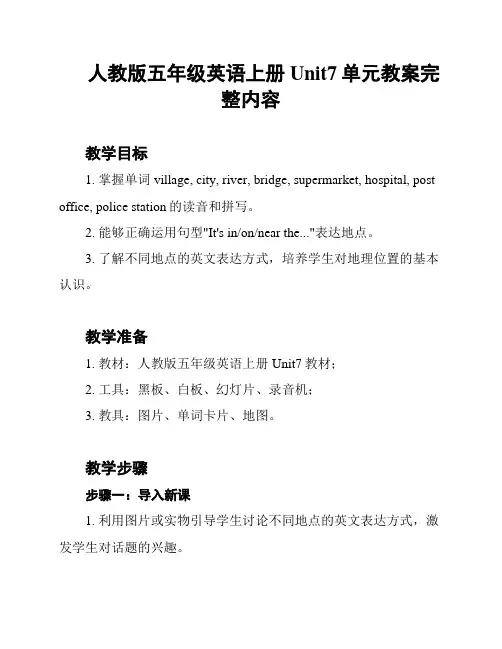
人教版五年级英语上册Unit7单元教案完整内容教学目标1. 掌握单词village, city, river, bridge, supermarket, hospital, post office, police station的读音和拼写。
2. 能够正确运用句型"It's in/on/near the..."表达地点。
3. 了解不同地点的英文表达方式,培养学生对地理位置的基本认识。
教学准备1. 教材:人教版五年级英语上册Unit7教材;2. 工具:黑板、白板、幻灯片、录音机;3. 教具:图片、单词卡片、地图。
教学步骤步骤一:导入新课1. 利用图片或实物引导学生讨论不同地点的英文表达方式,激发学生对话题的兴趣。
2. 师生互动,教师出示图片或说出地点,让学生尝试用"It'sin/on/near the..."句型回答。
步骤二:研究新词汇1. 出示词卡片,教授新词汇,包括village, city, river, bridge, supermarket, hospital, post office, police station。
2. 全班一起跟读,注意音标和发音。
3. 进行词汇游戏,让学生快速回答单词意思。
步骤三:研究句型1. 出示"It's in/on/near the..."句型的语法结构,解释其用法和意义。
2. 通过示范和练,让学生掌握这个句型,并能够用于不同地点的描述。
步骤四:综合运用1. 教师出示地图上的不同地点标记,让学生运用所学的句型描述地点。
2. 学生之间互相提问,回答对方的问题,巩固句型运用。
3. 进行小组活动,让学生分组描述自己所在的位置,并展示给全班。
步骤五:巩固和评价1. 制作练题,包括选择题、填空题等,帮助学生巩固所学内容。
2. 进行反馈和评价,根据学生的表现给予肯定和建议。
教学延伸1. 学生可以在班级或家庭中进行实地考察,使用所学的句型描述不同地点。
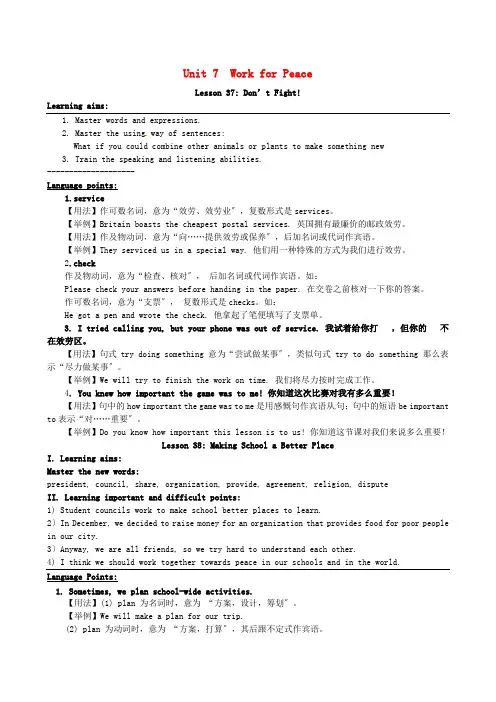
Unit 7 Work for PeaceLesson 37: Don’t Fight!Learning aims:1. Master words and expressions.2. Master the using way of sentences:What if you could combine other animals or plants to make something new3. Train the speaking and listening abilities.--------------------Language points:1.service【用法】作可数名词,意为“效劳、效劳业〞,复数形式是services。
【举例】Britain boasts the cheapest postal services. 英国拥有最廉价的邮政效劳。
【用法】作及物动词,意为“向……提供效劳或保养〞,后加名词或代词作宾语。
【举例】They serviced us in a special way. 他们用一种特殊的方式为我们进行效劳。
2.check作及物动词,意为“检查、核对〞,后加名词或代词作宾语。
如:Please check your answers bef ore handing in the paper. 在交卷之前核对一下你的答案。
作可数名词,意为“支票〞,复数形式是checks。
如:He got a pen and wrote the check. 他拿起了笔便填写了支票单。
3. I tried calling you, but your phone was out of service. 我试着给你打,但你的不在效劳区。
【用法】句式try doing something 意为“尝试做某事〞,类似句式 try to do something 那么表示“尽力做某事〞。
【举例】We will try to finish the work on time. 我们将尽力按时完成工作。
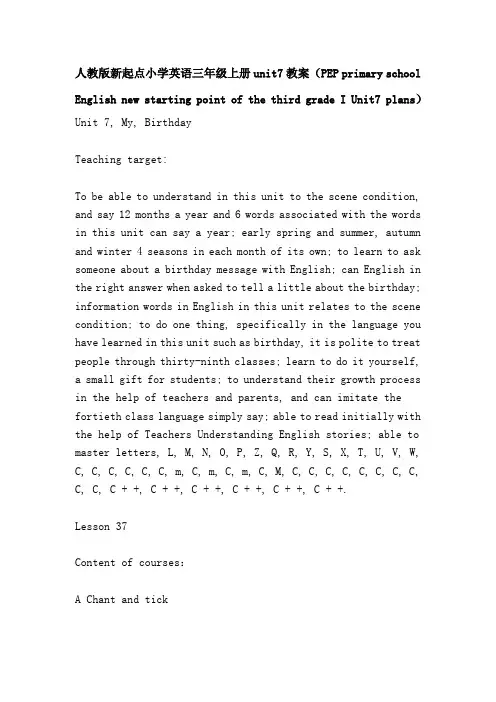
人教版新起点小学英语三年级上册unit7教案(PEP primary school English new starting point of the third grade I Unit7 plans)Unit 7, My, BirthdayTeaching target:To be able to understand in this unit to the scene condition, and say 12 months a year and 6 words associated with the words in this unit can say a year; early spring and summer, autumn and winter 4 seasons in each month of its own; to learn to ask someone about a birthday message with English; can English in the right answer when asked to tell a little about the birthday; information words in English in this unit relates to the scene condition; to do one thing, specifically in the language you have learned in this unit such as birthday, it is polite to treat people through thirty-ninth classes; learn to do it yourself, a small gift for students; to understand their growth process in the help of teachers and parents, and can imitate the fortieth class language simply say; able to read initially with the help of Teachers Understanding English stories; able to master letters, L, M, N, O, P, Z, Q, R, Y, S, X, T, U, V, W, C, C, C, C, C, C, m, C, m, C, m, C, M, C, C, C, C, C, C, C, C, C, C, C + +, C + +, C + +, C + +, C + +, C + +.Lesson 37Content of courses:A Chant and tickB Ask and answerC, Read, write, and, sayTeaching purpose:By looking at pictures and listening to songs, you can learn about 12 months in a year, learn to read the names of 12 months and the pronunciation of birthday, and learn to use the sentence patterns: My, birthday, is, in... Introduce your birthday month; understand how the 12 months are divided into four seasons: spring, summer, autumn and winter.Teaching emphasis:Learn the name, word, and birthday pronunciation of 12 months by rapping ballads.Teaching difficulties:The pronunciation of nouns in 12 months.Preparation before class:The wall charts, teaching tapes, word cards (teachers and students, teachers do their preparation) 12 paper cake cards, write above each month English.Teaching process:Listen to the song, the import unit play content: "I wish youHappy birthday song", please say it one song, guess in this unit we are going to learn about what the students say; the birthday after the teacher to seize the opportunity to ask them to birthday; Teacher Questioning: so you know you and your family's birthday? Ask several students to talk about it. Import this lesson: from today on, let's learn how to express birthdays in English. First of all, today we are going to study 12 months.Learn songs, learn 12 months and express your birthday:The teacher took out the December cake card: December: look and find a birthday in December students, the cake card to him and teach him and the theory of birthday is: My in December. and so on, to find out the birth in nine, ten and November students and learn the words September, October, November;The teacher asked them one by one: When is your birthday? The teacher motioned to hold the cake card standing in front of the blackboard students tell you their birth month, only they would say and remember your birth month on the line;Upset four card order, ask four students to find their own birth month cards, other students to disrupt the evaluation; four card order, let the other four students sent them to the four students of the birth month card, the other students and give correct evaluation;According to the above method to help teachers students' perception of new content: the second step learning March, April, May; the third step learning June, July, August; JanuaryFebruary; the fourth step learning, each time learning new words have to review the old words, rolling in the learning and memory of words;Listen to the chant. Again, ask the students to say what one hears the teachers voice the key words and sentences;Follow the tone of voice rehearsal ballads imitation audio recording, singing in unison with your fingers; all the songs, singing a few months was born to stand up in the months of the students, see who the fastest response;Students are encouraged to conduct group quiz activities,The teacher gives proper correction and guidance.Consolidate the expression of the month and learn to copy the words of the month:The teacher will copy the sentence on the blackboard, please read the representative sentence, review and consolidate students for 12 months of word reading ability; the My birthday is in read the sentence December.Observe the structure of the sentence in the book and ask the students to read the sentences, say what the sentences are missing, and ask the students to complete the sentences according to the actual situation and read them aloud;The teacher led the students to read 12 months, preliminary read every word spelling recognition, 12 words in your exercise book,edge copy edge spell.Classroom sections: Today, we, learned, new, words, about, twelve, We, knew, how, to, say, our, birthday., Then, we, learned, a, months., chant, about,, it., You, the, did, the, jobs., good,...Homework: Copy, the, new, words, January, to, June,, one, line, each, one.Writing on the blackboard: Unit 7, My, BirthdayLesson 37When, is, your, birthday?My, birthday, is, in, December.Lesson 38Content of courses:A, Make, a, chart, and, reportB Guess and playC Chant and doTeaching purpose:Through the questionnaire and guess the way to link the monthand season, and further consolidate the 37 lessons learned words and sentence patterns;Rap songs, play games, review and consolidate the knowledge about the month and birthday.Teaching emphasis:Questionnaire exercises, let students through questions and answers, consolidate the knowledge about the month and birthday.Teaching difficulties:Ask someone's birthday questions: Is, it, in... Intonation and answer: Yes, it, is. / No, it, isn, t.Preparation before class:The wall charts, teaching tapes and cards for teachers to make copies of questionnaire for birthday, group activities, students prepare a paper to write your name card paper cake candles, teachers prepare 12 above each write a month English namePreparation before class:Say a song and review the words for 12 months:Follow the tape 37 class singing songs, pay attention to students for the 12 months to verify the correct pronunciation;The teacher will break up the words in the 12 months and draw out any one. The students who are born in that month stand up and read the words aloud. Other students repeat them;The teacher introduced his birthday, inspired the students to remember the expression of the sentence, and asked several students to introduce their birthday month.Study your classmate's birthday month and learn to ask someone's birthday in english:Dialogue between teachers and students to strengthen communication:T:, When, is, your, birthday, S:, My, birthday,, is, in, January.The teacher demonstrates the use of the questionnaire and demonstrates it with a student:T:, When, is, your, birthday, Joy, S:, My, birthday, is,, in, July.The investigation request: To investigate you want to survey students under the seat, communicate with learned English, who use the Chinese students to give the corresponding punishment (recite a English ballads or songs) or the students ignored;Announce the result of the investigation, and ask the students to talk about the birthday of your classmate. The student willevaluate and the teacher will give a reward to the students who speak well;Guess, sing songs, learn the relationship between seasons and months:Show 37 class maps, tell the students: There are twelve months in a year. and What are asked them: they? Can you say them? Let the students out of 1 to 12 months in order to read words;Review several times, guide the students to carefully observe the teacher ask: How many chart seasons are there in a year? What are they? Ask the students to answer the questions, cultivate their ability of observation;Let the students continue to look at the pictures. The teacher asks questions: How, many, months, are, in, spring, Do, you, know, there, What, are, they. The students are taught to distinguish the seasons from their colors and their months,The goal is to gradually memorize words;Teacher and student questions and answers exercises allow students to sense the relationship between seasons and months:T:, Is, your, birthday, in, spring, S:, Yes.T:, Is, your, birthday, in, March, S:, No.T:, Is, your, birthday, in, May, S:, Yes., My, birthday,, is, in, May.Guess the game: listen to the tape, understand the rules of the game, the teacher and a student first demonstration, and then the same class students to play, in the guessing game with other students;Play the recordings of folk songs, listen to them and explain by classmates, and guide and correct them accordingly;Follow the tapes, learn songs, pay attention to pronunciation, intonation and rhythm;The whole class was singing, singing, singing and doing the movements, and making the corresponding actions to the lyrics of the ballads. The group performed a folk song show, performing competitions between groups, giving a good group reward for performances and singing.Classroom sections: Today, we, learned, relation, between, seasons, and, months., We, learned, a, chant, about, them., Then, we, played, a, twelve, game, about,, them., You, the, did, the, jobs., good,...Homework: Copy, the, words, July, to, December, one,, line, each, one.Writing on the blackboard: Lesson 38Is, your, birthday, in, spring?Is, your, birthday, in, May?Unit 7, My, BirthdayLesson 39Content of courses:A, Look, listen, and, sayB Let ', s, actC Let ', s, make, some, nice, thingsD Read and writeTeaching purpose:Listen to the tape and imitate the dialogue to review what you learned in the thirty-seventh, thirty-eighth lesson and the language used in the conversation;Learn how to make small gifts such as stone paintings for opposing comparisons and extravagance;Through the D part of the practice, let students put the knowledge into the pen.Teaching emphasis:Listen to the tape and imitate the dialogue, and carry on the oral communication activity, strengthen student'scommunicative ability.Teaching difficulties:When you make a picture of stone, do as you say.Preparation before class:The wall charts, teaching tapes, word cards, teachers and students to prepare a small gift for teachers and students to produce their own, stone painting materialsPreparation before class:Listen to the songs, talk practice, and review the knowledge about birthdays:Play "Happy Birthday to you" songs, the whole class along with recording, singing songs, stimulate students interest, atmosphere;Dialogue practice between teachers and students:T:, When, is, your, birthday, S:, My, birthday,, is, in, February.T:, What, do, you, want, do, on, your, birthday, S:, I, to, want, to, go,, to, the, zoo.Import this lesson: today Lily birthday, many children come to her birthday, would you like to go together? Now let's see who'scoming to Lily's house.Take part in birthday parties and develop students' communicative competence:Please show the wall charts, learned the language simply describes the figure representation of the content, or the teacher questions leads to dialog;Listen to the tape and think about what we said just now. Follow the tape and retell the dialogue, and the teacher will guide you in due course;The teacher performs a dialogue with the students in different roles, and then performs a sub role exercise between the groups. The teacher visits and studies the effect;Ask the students in the 2--3 group to perform a dialogue in front of the group, and reward the group and students who are good at it or read aloud. The teacher can simply guide the tone and movements;The class teaching pictures together and read the dialogue, encourage the students in the classroom, learning content of reciting class, digestion and absorption, to achieve the knowledge learned to use;Read the sentences in the D section of the book. Try to fill in the blanks with the missing words, and then read them aloud. The class corrects them. The teacher visits the instructions for writing letters.Hands-on production of birthday gifts, training students hands-on ability:The teacher asked, "what shall we give her for Lily's birthday?" The teacher suggested that we make the presents ourselves and send them to her, would you agree?The teacher shows some DIY gift, and then teach you to make stone paintings; while the teacher said to do, so that we understand a few words English meaning, strong learning ability of students can follow the teacher to retell the content of language:Wash, the, stone, paint, the, stone, draw, a, rabbit, or, another, animal, colour, the, rabbit, send, it,, to, my, friend.The teacher teaches the students how to make several other gifts: paper, flowers, birthday, card, picture, frame, print, paper;Please tell me what you will make and hand it up as a gift, and ask the students to come home and make one or two gifts for you.Class Today we Lily s party. We made a gift for her. Then attended we did the birthday exercise in lesson thirty-nine. You did the good jobs.Homework: Make, a, gift, to, your, friend.Writing on the blackboard: Lesson 39What, do, you, want, to, do, today?I, want, to, see, a, film.Lesson 40Content of courses:A, Look, listen, and, sayB Listen and matchC Read and writeD Let ', s, chantTeaching purpose:Let students know how to do different things at different ages and let them know how they grow up;Learn to express your future ideals in english;Able to master letters, L, M, N, O, P, Q, Z, R, Y, S, T, X, U, W, V, C, C, C, C, C, C, C, C, C, m, C, m, C, C, M, C, C, m, C, and I can master the pronunciation of the letters;Through the description of children from 0 to 8 years of growth process, let the students know that in their growth process, parents, teachers and social care and love, give studentsideological education.Teaching emphasis:Describe the different things you can do at different ages, and express your ideal sentence patterns.Preparation before class:The wall charts, teaching tapes, letters and cards for students of all ages own interesting photosPreparation before class:Practice the dialogue and review the knowledge you need to use in the text:Dialogue between teachers and students:T:, Hello., S:, Hello, Miss, Wang.T:, How, old, are, you, S:, I, am, 10, years, old.T:, When, is, your, birthday, S:, My, birthday,, is, in, August.T:, When, is, mom, s, birthday, your, S:, Her, birthday,, is, in, October.The whole class recites the ballad taught in this unit. Please act in groups of 1 to 2, and act on your own understanding;The teacher led the students in counting exercises: together, count from 0 to 10, count from 10 to 0, and then the teacher looked at the hand faster than the number. Who spoke fastest and who responded the fastest.Learn the text and understand your growth process:Show the wall charts and ask the students to organize the students in groups, and then discussed, while observing the image edge with Chinese or English say this is what;The teacher plays the tape two times, students follow the tape to retell the text content, and then according to their actual situation of the sentence is extended, such as: I am eight years old. I can sing English songs. I can make a toy plane;Paint a book on what you will do when you are eight years old, as the picture says;Think you can Jianjiankangkang up to now, to learn so many things who credit, then you have to do to repay their parents and teachers love? What do you want to be when you grow up? What's your ideal life?Play the tape: listen to what our friend's dream is Listen to the tape line, then check the answers me; teachers voice sentences: I want to be a doctor.Teachers and students ask and answer exercises to learn to express their ideals in english:T:你想成为什么?S:我想成为一名教师。
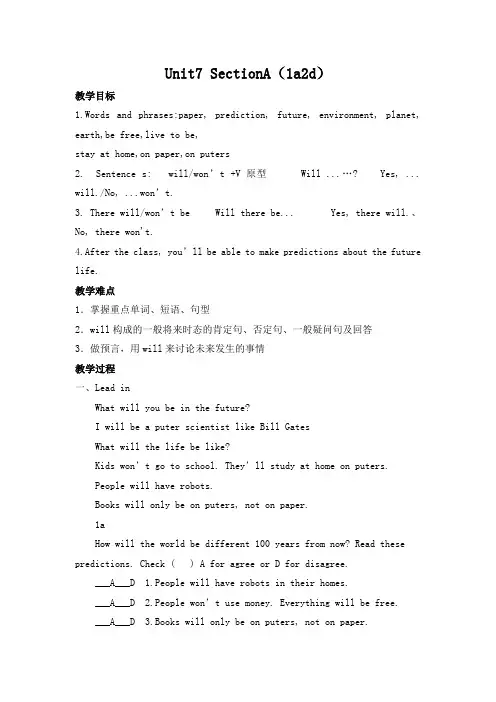
Unit7 SectionA(1a2d)教学目标1.Words and phrases:paper, prediction, future, environment, planet, earth,be free,live to be,stay at home,on paper,on puters2. Sentence s: will/won’t +V原型 Will ...…? Yes, ... will./No, ...won’t.3. There will/won’t be Will there be... Yes, there will.、No, there won't.4.After the class, you’ll be able to make predictions about the future life.教学难点1.掌握重点单词、短语、句型2.will构成的一般将来时态的肯定句、否定句、一般疑问句及回答3.做预言,用will来讨论未来发生的事情教学过程一、Lead inWhat will you be in the future?I will be a puter scientist like Bill GatesWhat will the life be like?Kids won’t go to school. They’ll study at home on puters.People will have robots.Books will only be on puters, not on paper.1aHow will the world be different 100 years from now? Read these predictions. Check ( ) A for agree or D for disagree.___A___D 1.People will have robots in their homes.___A___D 2.People won’t use money. Everything will be free.___A___D 3.Books will only be on puters, not on paper.___A___D 4.Kids won’t go to school.They’ll study at home on puters.___A___D 5.There will only be one country.___A___D 6.People will live to be 200 years old.1bListen and circle the predictions you hear.1.People will have robots in their homes.2.People won’t use money. Everything will be free.3.Books will only be on puters, not on paper.4.Kids won’t go to school. They’ll study at home on puters.5.There will be only one country.6.People will live to be 200 years old.A: Will….?B: Yes, they will/No, they won’t.Yes, there will./ No, there won’t.2bListen again. Check (√) the predictions you hear._____ 1. There will be fewer people._____ 2. There will be less free time._____ 3. People will use the subways less._____ 4. There will be more pollution._____ 5. Cities will be very big and crowded.Give a report about predictionsMy classmates make some predictions. First, for people,_____________________________. _____________________. Second, for free time, _______________________. Third, for environment,_______________________________ and___________________________. Last, for transportation(交通), _________________ and_____________________________.Reading the conversation and answer the questions.Nick: What are you reading, Jill?Jill: It’s a book about the future.Nick: Sounds cool. So what will the future be like?Jill: Well, cities will be more crowded and polluted. There will be fewer trees and the environment will be in great danger.Nick: That sounds bad ! Will we have to move to other planets.Jill: Maybe. But I want to live on the earth.Nick: Me, too. Then what can we do?Jill: We can use less water and plant more trees. Everyone should play a part in saving the earth.1. What is Jill reading?2. What will the future be like in the book?3. What can people do to save the earth?Read the conversations and fill in the chart.2cMake conversations about the predictions in 2a and 2b.A: What’s your prediction about the future?B: I think there will be more pollution.A: Really? I don’t think so. But I think there will be fewer trees.2dRead and answer the questions.1. What will the future be like according the book about the future?Cities will be more crowded and polluted. There will be fewer trees and the environment will be in great danger. Maybe people will have to move to other planets.2. What can people do to save the earth?We can use less water and plant more trees. We should play a part in saving the earth.1. Role play the conversation in groups;2. Role play the conversation in front of the classFill in the blanks according to the conversation.Jill is reading a book about the future. Can you imagine what ____ the future ____ like? Cities ___ ___ more crowded and polluted. There ___ ___ fewer treesand the environment ___ ___ in great danger.___ we ___ ___ move to other planets? What can we do to live on the earth? We can use ___ water and plant ____ trees. Everyone should ___ ___ ____ ___ savingthe earth.课堂练习同学们做exercisesthank you。
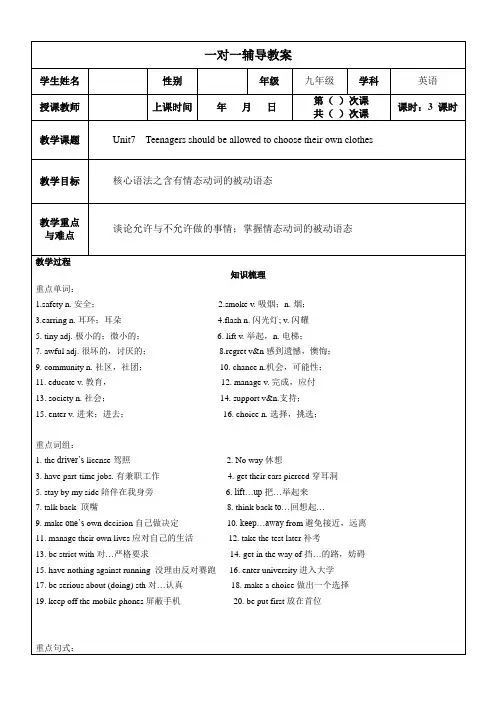

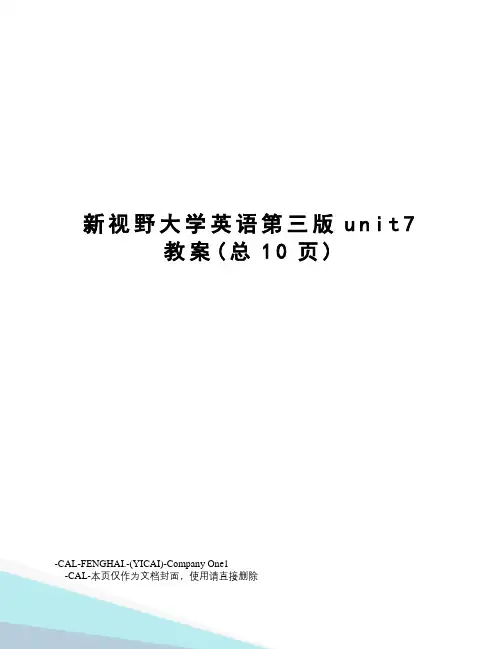
Unit 7Teenagers should be allowed to choosetheir own clothes.Section A (1a—2d)一、教学目标1.能熟练掌握下列词汇及短语:license, safety, smoke, should/should not be allowed to do, stop to do等2. 掌握重点句型:I don’t think sixteen-year-olds should be allowed to drive.I agree. They aren’t serious enough.Do you think teenagers should ...?Students should not be allowed to have part-time jobs.3. 能够运用“should (not) be allowed to do”谈论应该被允许和不应该被允许做某事。
4. 能够掌握“I agree/disagree.”或“I don’t agree.”来表达自己的观点。
5. 能够听懂日常生活中有关青少年能做和不能做的事情对话,并学会提取所需要的关键信息,同时能运用正确的表达方式编写对话。
6. 通过了解和反思自己的言行举止是否符合中学生日常行为准则,规范自己的言行,养成自觉遵守规则的良好习惯和优良品德。
正确看待“班规”,并认真遵守。
二、教学重点及难点重点:1. 掌握本单元出现的词汇、短语及目标语言。
2. 掌握“should (not) be allowed to do”谈论应该被允许和不应该被允许做某事。
难点:1. 运用“should (not) be allowed to do”谈论应该被允许和不应该被允许做某事。
2. 掌握“I agree/disagree.”或“I don’t agree.”来表达自己的观点。
三、教学准备教师:教学课件;多媒体设备学生:课前预习四、教学过程Task 1Step 1 Warming-upLook and talkT: Do you know how to describe rules?S1: …S2: …【设计意图】贴合生活实际,学生有表达欲望,能在保持较高兴趣的过程中快乐高效地学习,为1a活动的展开作铺垫。
用将来时.I can finish the work in two days.我两天之内能完成这项工作。
She will graduate in two years.她两年后毕业。
2)after指以过去时间为起点的“在一段时间以后”,所以与过去时态连用。
当after指某个特定的未来时刻或日期之后,或指一将来某一时间为起点的若干时间之后时,他可以与将来时态连用。
Eg.He started on Sunday and arrived in Beijing after three days.他周日启程三天后抵达的北京。
I’ll be back after three o’clock.他三点之后回来。
4.There will be fewer people.会有较少的人There will be less free time. 较少的空闲时间There will be more pollution.更多的污染fewer 是few 比较级,其后接名词复数。
“较少的,少量的”与less 是同义。
I have fewer friends in my class.在我们班我有较少的朋友。
less 是little 的比较级,其后接不可数名词。
“较少的,少量的”more 是many 和much 的比较级即可跟不可数名词也可跟复数名词。
“更多”He has more money and more friends 他有更多的钱和更多的朋友。
There will be less pollution in the future.将来会有较少的污染。
5.(be)in great danger.处于极度危险中。
They are in great danger .他们处于极度危险中We should save animals in danger. 我们应该拯救处于危险中的动物。
6.There are already robots working in factories. There be+n. +v.ing .某地有某人正在做某事There are many girls singing in the room . 有许多女孩正在房间里唱歌。
Unit 7Teenagers should be allowed to choose their own clothes.类别课程标准要求掌握的项目话题In this unit, students learn to talk about rules.重点单词Section A1.license n.证;证件2.safety n.安全;安全性3.smoke v.冒烟;吸烟n.烟4.tiny adj.极小的;微小的5.cry v.& n.哭;叫喊6.field n.田野;场地7.hug n.& v.拥抱;搂抱8.lift v.举起;抬高n.电梯;搭便车9.awful adj.很坏的;讨厌的10.regret v.& n.感到遗憾;懊悔Section B11.poem n.诗;韵文12.community n.社区;社团13.chance n.机会;可能性14.educate v.教育;教导15.manage v.完成;应付16.society n.社会17.avoid v.避免;回避18.product n.产品;制品19.handbag n.小手提包20.mobile adj.可移动的;非固定的重点短语1.the driver's license 驾照2.no way 休想3.have part-time jobs 有兼职工作4.get their ears pierced 穿耳洞5.stay by my side 陪伴在我身边6.lift …up 把……举起来7.talk back 顶嘴8.think back to…回想起……9.make one's own decision 自己做决定10.keep … away from 避免接近,远离11.manage their own lives 应对自己的生活12.take the test later 补考13.be strict with 对……严格要求14.get in the way of 挡……的路;妨碍15.have nothing againstrunning 没理由反对赛跑16.enter university 进入大学17.be serious about(doing)sth.对(做)某事认真18.make a choice做出一个选择19.keep off the mobilephones 屏蔽手机20.be put first 放在首位重点句型1.—I don't think sixteen-year-olds should be allowed to drive.我认为16岁的青少年不应被允许开车。
Unit7 Protect the Earth(Cartoon time)教案一、教学内容译林版小学英语六年级上册Unit 7 Protect the Earth(Cartoon time)二、教学目标1.知识目标:(1)能整体感知、理解Cartoon time中的对话内容。
(2)能听得懂、会说、会读词汇:project, protect, poster ,gate等。
2.能力目标:(1)能够在情境中运用所学词汇和句型进行交流。
(2)能用正确的语音语调,流利地朗读并表演文本对话。
3.情感态度目标:(1)培养学生积极参与、快乐合作的学习品质。
(2)进一步培养学生的环保意识。
三、教学重难点:(1)能整体感知、理解Cartoon time中的对话内容。
(2)能用正确的语音语调,流利地朗读并表演文本对话。
(3)能够在情境中运用所学词汇和句型进行交流。
四、教学准备PPT课件,图片及词条。
五、教学过程Step1 Warming-up1. Greetings.T: Hello! I’m Miss Mao. I’m your new English teacher. Nice to meet you! Do you like English? Do you like reading English stories?I have an English story. It’s funny. Do you want to read?T: But first, you should do a project.2. Let’s do!Do a project:(课件出示:project)(1)T: Can you read this word? (learn “project ”)What does it mean?Well, let’s do the project.(2)课件出示:A. Do a puzzle.小组内成员快速将信封内的碎图片拼成一幅完整的图片。
Unit 7 I’m not afraid!课时安排:第一课时 Part A、Part B第二课时 Part C、Part D第三课时 Part E、Part F、Part GPeriod 1一、教学目标(一)语言目标:1.词汇:(1)能听懂、会说、认读词组afraid, close, tired, difficult, clever, worry, kid. (2)能听懂、会说、认读词汇和短语monster, still , later on.2.句型:能用“I’m (not)… ”在实际情境中表达自己的感受。
(二)应用目标1. 能用“I’m (not)…”在实际情境中表达自己的情感和情绪。
2. 能用简单的语句表达产生情感和情绪的原因;3. 能在正确的情境下用英语“Don’t worry。
You are still a kid. You’ll be better later on.”来安慰他人。
4. 能听懂、会说A部分的对话。
二、教学重点及难点1.重点:能听懂、会说、认读、会写新单词afraid, close, tired, difficult, clever , worry, kid; 能用“I’m (not) …”来表达自己的感受2.难点:能在正确的情境下用英语“Don’t worry. You are still a kid. You’ll be better later on.”来安慰他人。
三、教学准备教学VCD,教学PPT。
四、教学步骤Step 1 Warming up1. Greetings2. Sing a songIf you are happyStep 2 Presentation1. New words教师与学生自由对话,引入新词的学习。
(1)tiredT:Hello... How are you?S: I’m fine, thanks. And you?T: I’m not very well. I am tired. (出示单词卡片tired,板书并带读新词。
三亚航空旅游职业学院教案编号Unit 7 Fads and Trends●Teaching MaterialForward English for Practical Purposes, Book 2, Unit 7●Teaching Aims:In this unit, students are supposed to1.master the words and expressions often used to talk about Fads and trends2.learn how to express complimenting and encouraging;3.understand the listening information about fashion.4.understand the main idea of Text A, and master the useful sentence structuresand words and expressions;5.master phonetic skill: rhythm and intonation;6.do some grammar practice– subjunctive mood7.know about some writing strategies and learn how to write an argumentative essay.●Teaching Emphasis1.to master the key language points and grammatical structures in the text;2.to know how to write an argumentative essay.●Teaching Difficulties1.to understand the main idea of Text A, master the key language points andgrammatical structures in the text.2.to use the expressions learnt to talk about fashion freely.3.to express one’s complimenting and encouraging..●Teaching ApproachesCommunicative approach and Computer-Assisted Instruction●Teaching Aidsa projectora multi-media computer system●Teaching Procedures and contents (8 periods)Part A Lead inTask 1Study the pictures and discuss the questions in small groups.1.Do you think the dress in the first picture will be popular amongordinary people?2.What do you think of the blue jeans the girl is wearing in the secondpicture?3. 3. Do you like T-shirts with words?Task 2 Listen to the short dialogues and fill in the blanks.Task 4 Listen to the recording, and complete the passage.Task 5Discuss the following questions with your partner about your understanding of fashion.1. Do you think the dress in the first picture will be popular among ordinarypeople?2.What do you think of the blue jeans the girl is wearing in the second picture? Text AWhat Is Fashion?Language and Cultural Points in the Textbombardv. to attack (a place) with bombs; to attack sb. withquestions, etc.e.g. Enemy positions were bombarded before our armyattacked.炮轰敌军阵地之后, 我军开始进攻。
The mayor was bombarded with questions.人们向市长连珠炮似地提出了许多问题。
revealv. to make (facts, etc.) known; to cause or allow (sth.)to be seene.g. I can’t reveal who told me.我不能透露是谁告诉我的。
The open door revealed an untidy kitchen.透过敞开的房门可以看见凌乱的厨房。
react toto behave differently or change as a result of sth.; toresponde.g. How did she react to the news?她对这个消息反应如何?People can react badly to certain food additives.有的人对某些食物添加剂会产生严重反应。
wordlessa. not expressed in wordse.g. She showed her wordless sympathy by sending flowersto her friend.她通过送花给她的朋友默默地表达了自己的同情。
Watching the beautiful sunrise, the boy felt a kind ofwordless joy.看着美丽的日出,男孩感受到一种莫名的快乐。
be/get involved into cause sb./sth. to take part in (an activity or asituation)e.g. He was involved in a heated argument.他参与了一场激烈的争论。
Don’t get me involved in solving your problems!你解决你的问题,不要把我拉进来!consciouslyad. (of actions, feelings, etc.) realized by oneself; being awakee.g. Fashion magazines give people ideas about thelatest fashion consciously.时装杂志有意识地引导人们对最新时装的看法。
He revealed the news to his colleague consciously.他故意把这个消息透露给了他的同事。
subconsciouslyad. of or concerning the thoughts, instincts, fears, etc.in the mind, of which one is not fully aware butwhich influence one’s actionse.g. Subconsciously, I was reacting against my unhappychildhood.我在下意识地对我不幸的童年进行反抗。
The mother was trying to protect her childrensubconsciously.母亲下意识地想要保护她的孩子。
artistica. of art and artistse.g. She comes from a very artistic family.她出身于很有艺术修养的家庭。
He was clear of the artistic value of his plays.他很清楚自己剧作的艺术价值。
triumphv. be successful or victoriouse.g. Common sense triumphed in the end.理智终于战胜了一切。
The team may triumph at last and win the worldchampionship.这支球队有可能最终获胜并赢得世界冠军。
suit ... to ...to make sth. appropriate for sth./sb.; to adapt sth.to sth./sb.e.g. The director changed the play to suit it to theaudience.导演修改了话剧以迎合观众的口味。
He is better suited to a job with older pupils.他较适合教小学高年级学生。
baggya. hanging looselye.g. He prefers baggy trousers to tight ones.他更喜欢宽松的裤子,不喜欢紧身的。
The hip-hop dancers performed on the stage in theirbaggy clothes.街舞表演者身着宽松的衣服在舞台上表演。
Part BText B The Difference Between Trends and Fads( home reading)Part C Phonetics and WritingPhonetics : Rhythm and Intonation1. 节奏是指话语里重读音节和非重读音节的排列模式。
而英语口语中的节奏基本体现在各个重读音节(用O表示)之间的时距大体相等。
英语是一种以重音计时的语言,各个重音与它后面跟随的若干轻读音节(用o表示)构成一个节奏群。
有时一个节奏群是以一个空拍(用^表示)开始的,空拍在英语中也叫做“silent stress”,每个节奏群之间用“/”来相隔。